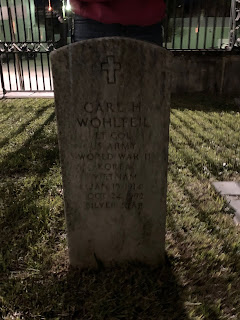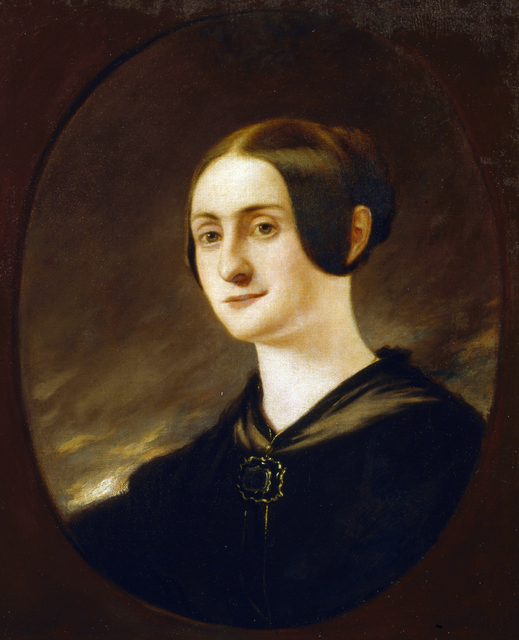 Carl H. Wohlfeil
Carl H. Wohlfeil1914-1992
To the left we have a military grave marker. The title of this type of headstone is pretty much self-explanatory; a typical gravestone of a man or women who died in the service of the armed forces. Often, a religious emblem is positioned at the top of the stone slab. The most common symbols are the Christian Cross or the Star of David for Judaism.
To the right is an unmarked mausoleum found in the first cemetery we visited.
 Mausoleums were first seen around 300 B.C along the Mediterranean coast. They are incredibly popular for wealthy individuals and in the past, emperors and kings such as during the Roman Empire. One of the most well-known mausoleums is, in fact, the Taj Mahal. This particular example was around the size of a common bedroom, but the inhabitant will most likely be unknown forever due to the loss of church records during the Civil War.
Mausoleums were first seen around 300 B.C along the Mediterranean coast. They are incredibly popular for wealthy individuals and in the past, emperors and kings such as during the Roman Empire. One of the most well-known mausoleums is, in fact, the Taj Mahal. This particular example was around the size of a common bedroom, but the inhabitant will most likely be unknown forever due to the loss of church records during the Civil War. To the right:
To the right:Sophia M. Elfe
Beloved wife: Died May 31st 1878
This is a beautiful example of is an example of a broken die on socket with an inscription to a beloved wife from her husband, praising her memory. Die on sockets consist of two pieces which are attached with iron rods made inside the base, and up through the die portion. Here the stone die itself has been partially destroyed.
Below, Left:
Georgeanna Hume
1819-1855
 This is a die, base, and cap, which is three separate stones which have been put together. First, on the bottom is the base, then the die (the large stone inscription portion), with a cap on top completing the piece. The most striking portion of this headstone is the engraved dove image. Doves stand for innocence and purity, most likely a final parting compliment from her husband.
This is a die, base, and cap, which is three separate stones which have been put together. First, on the bottom is the base, then the die (the large stone inscription portion), with a cap on top completing the piece. The most striking portion of this headstone is the engraved dove image. Doves stand for innocence and purity, most likely a final parting compliment from her husband.
Right:
Pictured here is a broken pillar tomb, known for its Greek and Roman symbolism of the pillar of life cut short in an early death. It was often used for the head of the family, and the wreath on the head of the pillar symbolizes the victory in death similar to that of a laurel wreath.
Left:
Alexander Gibson and Anna Maria Gibson, husband and wife.
The ledgers pictured above belong to the Gibson couple. Their striking cursive style inscriptions detail their loved ones appreciation and care towards the two. What is most interesting about ledgers is the fact that not only are they commonly found in cemeteries or graveyards, but they are also commonly used within church sanctuaries for important figures of the church who are buried within their walls. You can find some of the most beautiful ledgers in the churches of The Basilica of Santa Croce, which often have life-size carvings of the entombed. For basic information you can visit their website here.

Right:
S.R. Pickens is buried in the right hand cradle grave in the image to the right. A cradle grave can also be known as a bedstead, which is more commonly used for adults. These are made to resemble a bed or cradle, as the name would suggest, with a headboard at the top, and occasionally even another stone as a foot-board. Most often there would have been a layer of flowers or bushes within the "bed," although time has left the graves in need of more maintenance than can be afforded by the church. They were most common during the era of the civil war.

Left:
W. A. King
This is most commonly called a box tomb, and has been popular throughout several eras of English history. The occupants of the tomb are actually generally buried beneath the box, which is used to identify and create a large, decorative "tomb" structure. These actually bear a striking resemblance to what is known as a stone box grave, common in the Native American Mississippian Culture. Although a slightly more crude box, due to the lack of stone tools at the time, it's general composition is an almost perfect match, despite being developed an ocean apart.
 Left:
Left: This headstone is a die on base, which differs from the other two "die" headstones because it consists of a large two-section base with a die on top, but no separate cap. The reason I chose to include this subtle difference is because of the intricate carvings on this stone. We can see a soul effigy present on the top, with a child sleeping underneath, which usually indicates that a young child or a mother, who perhaps died in childbirth lays under this stone.
This headstone is a die on base, which differs from the other two "die" headstones because it consists of a large two-section base with a die on top, but no separate cap. The reason I chose to include this subtle difference is because of the intricate carvings on this stone. We can see a soul effigy present on the top, with a child sleeping underneath, which usually indicates that a young child or a mother, who perhaps died in childbirth lays under this stone.Above, Right:
This particular grave marker was one of the most interestingly-designed that I saw while at these cites. The cross on top was wrapped in ivy while the bottom design resembled a pile of stones, resembling a cairn or tomb. This can be related to the faith of the deceased also, as a stone tomb was where Jesus of the Christian Bible was buried and subsequently resurrected. Along with that, it is also a symbol of endearment, as setting a rock on a grave is said to commemorate the deceased under the idea of the resurrection, Eastern European folklore, or even Jewish commemorative tradition.
This trip was full of information and a welcome trip beyond my comfort zone. This assignment allowed me to research some fascinating information and to talk about some topics that I am passionate about. I thoroughly enjoyed getting a chance to see and research everything I have learned about. All of these gravestone examples came from the following two church cemeteries in the heart of Charleston. If you have a chance to explore the area here are some amazing options to discover for yourself. Their websites also include the basic history of their church's founding:
Cathedral Church of St. Luke and St. Paul - an Anglican church located at 126 Coming St.
St. Patrick Catholic Church - located at 134 St. Philip St.





No comments:
Post a Comment